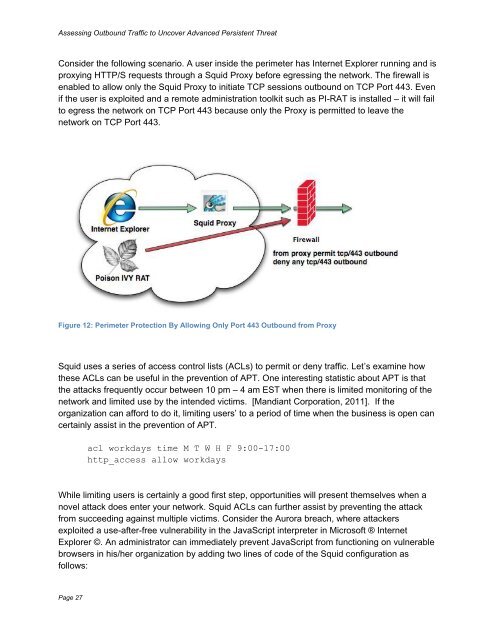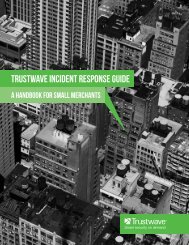JWP-Binde-McRee-OConnor
JWP-Binde-McRee-OConnor
JWP-Binde-McRee-OConnor
You also want an ePaper? Increase the reach of your titles
YUMPU automatically turns print PDFs into web optimized ePapers that Google loves.
Assessing Outbound Traffic to Uncover Advanced Persistent Threat<br />
Consider the following scenario. A user inside the perimeter has Internet Explorer running and is<br />
proxying HTTP/S requests through a Squid Proxy before egressing the network. The firewall is<br />
enabled to allow only the Squid Proxy to initiate TCP sessions outbound on TCP Port 443. Even<br />
if the user is exploited and a remote administration toolkit such as PI-RAT is installed – it will fail<br />
to egress the network on TCP Port 443 because only the Proxy is permitted to leave the<br />
network on TCP Port 443.<br />
Figure 12: Perimeter Protection By Allowing Only Port 443 Outbound from Proxy<br />
Squid uses a series of access control lists (ACLs) to permit or deny traffic. Let’s examine how<br />
these ACLs can be useful in the prevention of APT. One interesting statistic about APT is that<br />
the attacks frequently occur between 10 pm – 4 am EST when there is limited monitoring of the<br />
network and limited use by the intended victims. [Mandiant Corporation, 2011]. If the<br />
organization can afford to do it, limiting users’ to a period of time when the business is open can<br />
certainly assist in the prevention of APT.<br />
acl workdays time M T W H F 9:00-17:00<br />
http_access allow workdays<br />
While limiting users is certainly a good first step, opportunities will present themselves when a<br />
novel attack does enter your network. Squid ACLs can further assist by preventing the attack<br />
from succeeding against multiple victims. Consider the Aurora breach, where attackers<br />
exploited a use-after-free vulnerability in the JavaScript interpreter in Microsoft ® Internet<br />
Explorer ©. An administrator can immediately prevent JavaScript from functioning on vulnerable<br />
browsers in his/her organization by adding two lines of code of the Squid configuration as<br />
follows:<br />
Page 27










